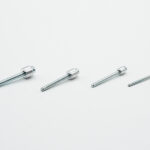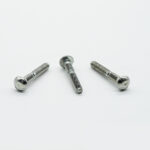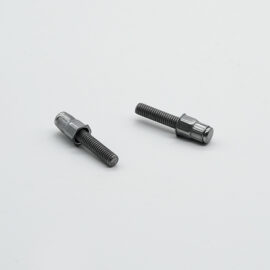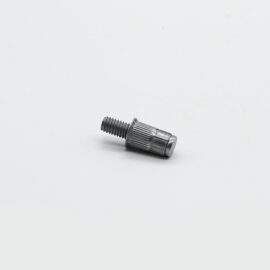BSL® pull rivet studs can achieve non-destructive and quick connection of prefabricated holes on automotive sheet metal, and provide external thread support.
BSL® pull rivet studs are made of rivet nut parts and bolt parts pressed together. The studs are connected to the sheet metal holes at one time by pull riveting, providing external thread support, and can also meet the requirements of anti-loosening, anti-rotation, waterproof sealing, etc.
Connection features:
1. Provide threaded connection for metal sheets; solve the problem of easy melting and change of welding bolts of metal sheets and thin tubes;
2. Single-sided installation, high efficiency
3. Firm riveting
4. Low installation cost
5. Can adapt to riveted plates of various materials (steel, aluminum, plastic, etc.)
Usage scenarios
BSL® pull rivet studs are divided into flat head type, countersunk head type, hexagonal type, and cylindrical outer pattern type according to the head and rod type of the rivet nut.
According to the requirements of anti-loosening and sealing and waterproofing, two gluing methods can be combined: gluing at the screw part and gluing at the root of the nut flange.
Apply prefabricated holes of different shapes of sheet metal and installation plane requirements.
size
| Product Code | D | d | dk | k | L | L1 | S0 | h1 | h |
| 公称 | Max | Max | Max | Max | Min | ||||
| B1141-YW-050145_100 | M5 | 6.98 | 10.5 | 1.2 | 14.5 | 10 | 7.0-7.1 | 12.5-14.0 | 0.5-3.0 |
| B1141-YW-050145_150 | 15 | 17.5-19.0 | 0.5-3.0 | ||||||
| B1141-YW-060175_150 | M6 | 8.98 | 13.5 | 1.65 | 17.5 | 15 | 9.0-9.1 | 17.5-19.0 | 1.0-3.0 |
| B1141-YW-060175_200 | 20 | 22.5-24.0 | 1.0-3.0 | ||||||
| B1141-YW-060175_250 | 25 | 27.5-29.0 | 1.0-3.0 | ||||||
| B1141-YW-060175_300 | 30 | 32.5-34.0 | 1.0-3.0 | ||||||
| B1141-YW-060195_150 | 19.5 | 15 | 17.5-19.0 | 3.0-5.0 | |||||
| B1141-YW-060195_200 | 20 | 22.5-24.0 | 3.0-5.0 | ||||||
| B1141-YW-060195_250 | 25 | 27.5-29.0 | 3.0-5.0 | ||||||
| B1141-YW-060195_300 | 30 | 32.5-34.0 | 3.0-5.0 | ||||||
| B1141-YW-080185_150 | M8 | 10.98 | 16.5 | 1.8 | 18.5 | 15 | 11.0-11.1 | 17.5-19.0 | 1.0-3.0 |
| B1141-YW-080185_200 | 20 | 22.5-24.0 | 1.0-3.0 | ||||||
| B1141-YW-080185_250 | 25 | 27.5-29.0 | 1.0-3.0 | ||||||
| B1141-YW-080185_300 | 30 | 32.5-34.0 | 1.0-3.0 | ||||||
| B1141-YW-080205_150 | 20.5 | 15 | 17.5-19.0 | 3.0-5.0 | |||||
| B1141-YW-080205_200 | 20 | 22.5-24.0 | 3.0-5.0 | ||||||
| B1141-YW-080205_250 | 25 | 27.5-29.0 | 3.0-5.0 | ||||||
| B1141-YW-080205_300 | 30 | 32.5-34.0 | 3.0-5.0 |
Performance Table
| Thread size D (mm) | Installation torque N.M (max) | Thread load N (min) | Breaking torque (N.M)min |
Rotation torque (N.M)min |
| M5 | 6 | 8230 | 7.6 | 2 |
| M6 | 10 | 11600 | 13 | 4.5 |
| M8 | 12 | 21200 | 33 | 5.5 |
Surface treatment
| variety | Material | Surface treatment | ||
| Nuts | Screw | Nuts | Screw | |
| Flat head cylindrical outer pattern | SWCH10A | SWCH35K
10B21 |
Galvanized
/Zinc-nickel alloy |
Galvanized
/Zinc-nickel alloy |
Installation Method
1.1 Product installation steps
1) Select a pneumatic rivet stud gun that matches the pulling force, install a nozzle that matches the diameter specification, and adjust the appropriate riveting stroke according to the installation thickness and the tool manual;
2) Load the product and perform an empty pull test;
3) Perform a real riveting test on the test sheet metal, as shown in step 1 below.
4) Observe whether the clamping state of the product is normal after installation.
5) (To determine whether the installation fails, please refer to the following article – Product installation failure mode pictures)
1.2 Operation steps
Hold the product and gently push the screw into the gun head. Note that the product should be kept in a vertical direction. At this time, the tool gun head automatically rotates, screws in the screw until it is close to the nut plane, and then inserts the tool into the installation hole in a direction perpendicular to the sheet metal plane and close to the sheet metal surface, then pulls the trigger, the screw rotates forward to start riveting, and the gun head automatically rotates back to the position after the stroke reaches the end. At this time, one riveting action ends, and then the next working cycle is carried out.



























































